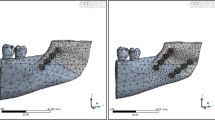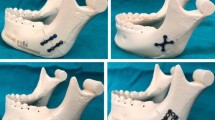Abstract
Objective
The purpose of this study was to compare, by mechanical in vitro testing, a regular 5-hole plate and a long 4-hole plate with a regular 4-hole plate, applied to stabilize a simulated mandibular angle fracture.
Study design
The plates from the 2.0-mm titanium-based system were adapted and stabilized passively in the same site in both groups using four screws, 6 mm long. During the resistance-to-load test, the force was applied perpendicular to the occlusal plane at three different points: first molar at the plated side, first molar at the contralateral side, and between the central incisors.
Results
The regular 5-hole plates and longer 4-hole plates were superior to the regular 4-hole plates. Furthermore, no statistically significant difference was found between the regular 5-hole plates and long 4-hole plate.
Conclusions
The length and shape of plates did not interfere with the effectiveness to stabilize the fragments.







Similar content being viewed by others
References
Shetty V, Caputo A (1992) Biomechanical validation of the solitary lag screw technique for reducing mandibular angle fractures. J Oral Maxillofac Surg 50(6):603–7
Wittenberg JM, Mukherjee DP, Smith BR, Kruse RN (1997) Biomechanical evaluation of new fixation devices for mandibular angle fractures. Int J Oral Maxillofac Surg 26(1):68–73
Ellis E 3rd (1999) Treatment methods for fractures of the mandibular angle. Int J Oral Maxillofac Surg 28(4):243–52
Alkan A, Celebi N, Ozden B, Bas B, Inal S (2007) Biomechanical comparison of different plating techniques in repair of mandibular angle fractures. Oral Surg Oral Med Oral Pathol Oral Radiol Endod 104(6):752–6
Mehra P, Murad H (2008) Internal fixation of mandibular angle fractures: a comparison of 2 techniques. J Oral Maxillofac Surg 66(11):2254–60
Bayat M, Garajei A, Ghorbani K, Motamedi MH (2010) Treatment of mandibular angle fractures using a single bioresorbable miniplate. J Oral Maxillofac Surg 68(7):1573–7
Schierle HP, Schmelzeisen R, Rahn B, Pytlik C (1997) One- or two-plate fixation of mandibular angle fractures? J Craniomaxillofac Surg 25(3):162–8
Iida S, Hassfeld S, Reuther T, Nomura K, Muhling J (2005) Relationship between the risk of mandibular angle fractures and the status of incompletely erupted mandibular third molars. J Craniomaxillofac Surg 33(3):158–63
Gear AJ, Apasova E, Schmitz JP, Schubert W (2005) Treatment modalities for mandibular angle fractures. J Oral Maxillofac Surg 63(5):655–63
Guimond C, Johnson JV, Marchena JM (2005) Fixation of mandibular angle fractures with a 2.0-mm 3-dimensional curved angle strut plate. J Oral Maxillofac Surg 63(2):209–14
Michelet FX, Deymes J, Dessus B (1973) Osteosynthesis with miniaturized screwed plates in maxillo-facial surgery. J Maxillofac Surg 1(2):79–84
Champy M, Wilk A, Schnebelen JM (1975) Tretment of mandibular fractures by means of osteosynthesis without intermaxillary immobilization according to F.X. Michelet’s technic. Zahn Mund Kieferheilkd Zentralbl 63(4):339–41
Hochuli-Vieira E, Ha TK, Pereira-Filho VA, Landes CA (2011) Use of rectangular grid miniplates for fracture fixation at the mandibular angle. J Oral Maxillofac Surg 69(5):1436–41
Bredbenner TL, Haug RH (2000) Substitutes for human cadaveric bone in maxillofacial rigid fixation research. Oral Surg Oral Med Oral Pathol Oral Radiol Endod 90(5):574–80
Bregagnolo LA, Bertelli PF, Ribeiro MC, Sverzut CE, Trivellato AE (2011) Evaluation of in vitro resistance of titanium and resorbable (poly-L-DL-lactic acid) fixation systems on the mandibular angle fracture. Int J Oral Maxillofac Surg 40(3):316–21
Ellis E 3rd, Throckmorton GS (2001) Bite forces after open or closed treatment of mandibular condylar process fractures. J Oral Maxillofac Surg 59(4):389–95
Tate GS, Ellis E 3rd, Throckmorton G (1994) Bite forces in patients treated for mandibular angle fractures: implications for fixation recommendations. J Oral Maxillofac Surg 52(7):734–6
Gerlach KL, Schwarz A (2002) Bite forces in patients after treatment of mandibular angle fractures with miniplate osteosynthesis according to Champy. Int J Oral Maxillofac Surg 31(4):345–8
Champy M, Lodde JP, Schmitt R, Jaeger JH, Muster D (1978) Mandibular osteosynthesis by miniature screwed plates via a buccal approach. J Maxillofac Surg 6(1):14–21
Schaaf H, Kaubruegge S, Streckbein P et al (2011) Comparison of miniplate versus lag-screw osteosynthesis for fractures of the mandibular angle. Oral Surg Oral Med Oral Pathol Oral Radiol Endod 111(1):34–40
Choi BH, Yoo JH, Kim KN, Kang HS (1995) Stability testing of a two miniplate fixation technique for mandibular angle fractures. An in vitro study J Craniomaxillofac Surg 23(2):123–5
Rudman RA, Rosenthal SC, Shen C, Ruskin JD, Ifju PG (1997) Photoelastic analysis of miniplate osteosynthesis for mandibular angle fractures. Oral Surg Oral Med Oral Pathol Oral Radiol Endod 84(2):129–36
Ellis E 3rd, Ghali GE (1991) Lag screw fixation of mandibular angle fractures. J Oral Maxillofac Surg 49(3):234–43
Nissenbaum M, Lownie M, Cleaton-Jones P (1997) Relative displacement resistance of standard and low-profile bone plates in experimental mandibular angle fractures. Oral Surg Oral Med Oral Pathol Oral Radiol Endod 83(4):427–32
Haug RH, Fattahi TT, Goltz M (2001) A biomechanical evaluation of mandibular angle fracture plating techniques. J Oral Maxillofac Surg 59(10):1199–210
Esen A, Dolanmaz D, Tuz HH (2012) Biomechanical evaluation of malleable noncompression miniplates in mandibular angle fractures: an experimental study. Br J Oral Maxillofac Surg 50(5):e65–8
Ribeiro-Junior PD, Magro-Filho O, Shastri KA, Papageorge MB (2010) In vitro evaluation of conventional and locking miniplate/screw systems for the treatment of mandibular angle fractures. Int J Oral Maxillofac Surg 39(11):1109–14
Haug RH, Barber JE, Reifeis R (1996) A comparison of mandibular angle fracture plating techniques. Oral Surg Oral Med Oral Pathol Oral Radiol Endod 82(3):257–63
Levy FE, Smith RW, Odland RM, Marentette LJ (1991) Monocortical miniplate fixation of mandibular angle fractures. Arch Otolaryngol Head Neck Surg 117(2):149–54
Kimsal J, Baack B, Candelaria L, Khraishi T, Lovald S (2011) Biomechanical analysis of mandibular angle fractures. J Oral Maxillofac Surg 69(12):3010–4
Trivellato PF, Pepato AO, Ribeiro MC, Sverzut CE, Trivellato AE (2013) In vitro evaluation of the resistance of a 2.0-mm titanium fixation system in the sectioned angle without continuity of the inferior border of the mandible. Int J Oral Maxillofac Surg
Conflicts of interest
None
Author information
Authors and Affiliations
Corresponding author
Rights and permissions
About this article
Cite this article
Yamaji, M.A.K., de Oliveira Neto, P.J., de Campos Ribeiro, M. et al. Evaluation of in vitro resistance of different 2.0-mm titanium plates on the mandibular angle sectioning. Oral Maxillofac Surg 19, 65–70 (2015). https://doi.org/10.1007/s10006-014-0456-3
Received:
Accepted:
Published:
Issue Date:
DOI: https://doi.org/10.1007/s10006-014-0456-3




